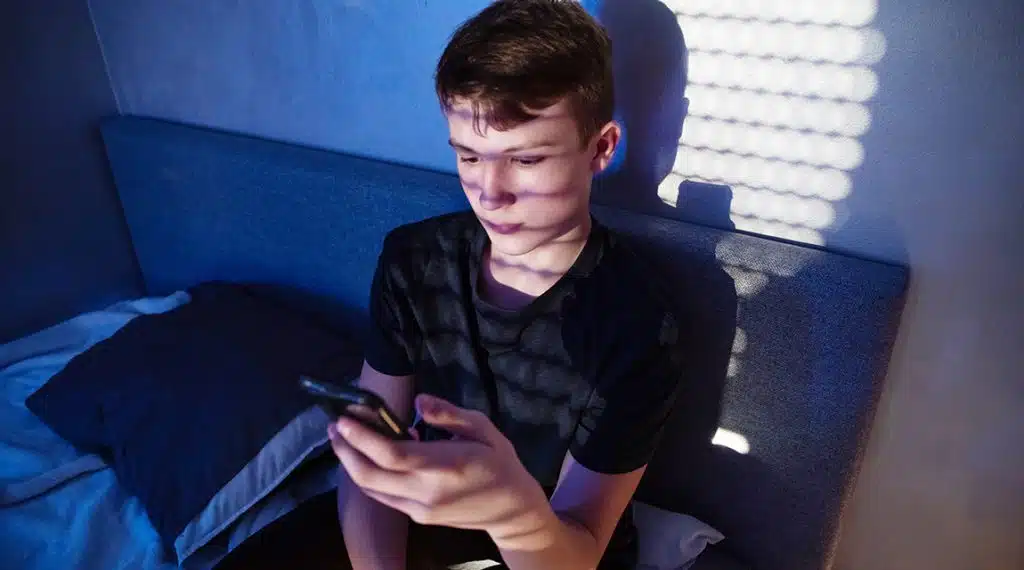In our hyperconnected world, people of all ages have instant access to what’s happening around the globe. Vivid images and sounds of violence and harm—such as news reports of the school shooting in Nashville earlier this week—can invade our homes and our psyches in the blink of an eye.
Even if we understand intellectually that what’s happening is far away and does not endanger our physical safety, our nervous systems may still process the threat as if it was happening directly to us. This is known as secondary trauma, and adolescents are particularly vulnerable to this form of trauma. Because their brains are still developing, it’s difficult, if not impossible, for them to reason away the body’s fight-or-flight reaction.
As a result, witnessing suffering, fear, and destruction—whether on the news, online, or on their social media feeds—can have both short- and long-term impacts on young people’s mental and physical health.
10 Tips for Talking to Teens About Tragic Events
Talking about what’s happening is the best approach for how to help a child after a traumatic event. Discussing the event with a trusted adult—a parent, grandparent, therapist, or guidance counselor—can help children and teenagers process their feelings.
Even if a teen appears indifferent to the event, it’s important to talk about it. They may be feeling strong emotions under the stoic front. The first step is opening a safe space for communication.
How to Start the Conversation
Begin by finding out what they already know. Ask them what they have heard about the event. Make sure you’re informed beforehand so you can fill in missing facts about the event that they might not be aware of.
Let them take the lead. Rather than guiding the conversation, ask open-ended questions and find out what they’re thinking and what they want to know. You might be surprised: The issues that come up for teenagers aren’t always the same ones that adults grapple with.
Use age-appropriate language. Children and younger teens may not understand the feelings they’re having or why someone around them is scared or anxious. However, they can understand the idea of two people having disagreements and struggling over something both of them want.
Help them see the bigger picture. For older adolescents, it may be helpful to understand some of the background leading up to a tragic event. Having a historical perspective can actually provide a sense of reassurance—a reminder that this too shall pass—if a child is struggling with war anxiety or other types of anxiety related to tragic events.
Stay Open and Authentic
Be honest. Teens are savvy and they already know a lot about what the world is like. Don’t mince words or try to sugarcoat what’s happening. It’s important for teens to trust the adults around them and to know they can go to them for honest answers.
Reassure them that they’re not alone in their feelings. Let them know that their sadness, fear, anxiety, confusion, anger—or whatever they are experiencing—is a natural reaction to a disturbing and violent situation.
Share your own reaction, without going overboard. It’s okay to let teens know that you, too, find this event troubling and sad. But adults shouldn’t use the discussion with their kids to process their own emotions. That may create more anxiety for the child or teen. Validation is okay; venting is not.
Follow Up Afterward
Keep checking in. Talking to teens about tragic events or their fear of war should not be a one-and-done conversation. Be sure to check in every few days to see how your teen is feeling, particularly if they are exhibiting signs of stress. Don’t push them to talk if they don’t want to, but make sure they know you are there for them when they do.
Monitor how they’re doing. Continue to watch for physical and behavioral signs that may indicate a teen is struggling. Remember that irritability and anger may be masking feelings of fear and distress.
Be present and loving. Let them know that you are there for them, that you will always do your best to keep them safe, and that they can come to you at any time for support. Even if they don’t want to talk about it, simply doing something enjoyable or comforting together can help them feel better.

Recognizing Secondary Trauma in Children and Teens
It can be difficult to figure out how to help a child after a traumatic event. Not all teens are able or willing to speak openly about their distress and fear of war or other tragic and violent events. They may feel embarrassed that they are so deeply affected by a situation that doesn’t directly impact their safety. Or they may not realize that the discomfort they’re experiencing is related to what they’re seeing in the media.
Therefore, it’s important for parents and other mentors to watch for the signs that a teen may be experiencing secondary trauma. This is particularly true for young people who are already struggling with an anxiety disorder or mental health issue, as there is a higher risk of developing a phobia or war or other types of tragic events.
Here are some of the ways tragic events can effect adolescent emotional and cognitive behavior:
- Sleep issues: Insomnia, nightmares, or oversleeping in the morning after a difficult night indicate that a teen may be experiencing intense anxiety or distress.
- Physical problems: Children or teens may complain about stomachaches, headaches, or loss of appetite.
- Behavioral changes: Irritability and aggressive behavior can be signs of anxiety.
- Substance abuse: Teens may increase their use of alcohol or drugs as a way to self-medicate the emotions brought up by the event. Learn about signs of teen substance abuse.
- Becoming clingy: Teens who had previously been drawing away from their parents as they move toward independence may become clingy and attached.
How to Help a Child After a Traumatic Event: 6 Practices to Help Process Secondary Trauma
After a traumatic response, young people need to shift their minds and bodies out of the fight-or-flight response and into the rest-and-digest system, to help restore a state of balance, health, and hope. Here are six evidence-based practices for calming and relaxing the nervous system.
Journaling: Writing about what they’re feeling can help teens process what they’re seeing and the emotions they’re experiencing. In one study, researchers compared the effect of EMDR on adolescent trauma survivors with that of a therapeutic writing intervention. The approaches were equally effective in reducing PTSD reactions, anxiety, depression, and behavioral problems.
Self-expression without words: Some teens might have strong emotions about the event but have trouble putting it into words. However, there are other ways they can process their emotions. Making art, playing an instrument, or movement (dancing, yoga, or martial arts, for example) are all positive ways to express what they are feeling.
Remembering the good in the world: After a tragedy, it’s easy to focus on the negative. Remind your teen that most people are good at heart and want to help others, not hurt them. You might want to share personal stories or stories in the media that illustrate how people are helping and caring for their fellow humans.
Self-compassion: Young people may people feel guilty about feeling stressed or traumatized even though they are physically safe while others are directly impacted. Remind them that their feelings are a natural and human response to a disturbing event, no matter the level of exposure. The ability to empathize with others’ pain is a strength. However, it may take time for them to learn how to experience empathy without internalizing others’ distress.
Connection: Teens may want to reach out to close friends, extended family, or mentors they trust. Multiple studies have shown that positive social relationships strengthen resilience and positive emotions, which help them overcome war anxiety or other forms of secondary trauma.
Unplugging: During times when the news is particularly distressing, a digital detox can help decrease trauma triggers. In addition, unplugging on a regular basis frees up time for healthy activities that bring teens into the present moment, such as being in nature and moving their bodies. Rather than sitting inside looking at their phone, seeing content that can magnify their fear of war or other frightening events, they can rebalance their nervous systems through physical activity and time outdoors.
Professional Support for Secondary PTSD
In conclusion, it’s important for both teens and parents to remember that it’s natural to feel distress and grief in the face of tragedy and violence. The key is finding healthy ways to move forward.
If a child or teen continues to struggle with traumatic stress, the risk of developing PTSD increases. That’s why it’s so critical to address these feelings immediately and to follow up afterward. If a child’s distress is not alleviating over time, don’t hesitate to reach out to a mental healthcare professional. Short-term counseling, teen talk therapy, or a support group may be helpful for teens who are having difficulty processing their emotions.
If your child, or an adolescent you work with, needs support for coping with war anxiety specifically, or secondary trauma in general, please reach out to us. Our Admissions experts can help you find the care and resources you and your teen need.






